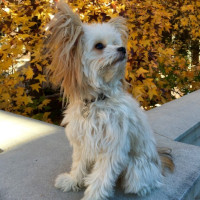Appearance of the Papi-Poo
|
| The Papi-Poo has a well-proportioned body with short but strong legs. The head is often rounded and their ears are set wide apart and can be long and floppy or pricked, giving them an alert appearance. While puppies can vary in appearance even within the same litter, this little dog generally looks like an attractive stuffed animal that has come to life. With soft feathers around their medium-length muzzle and furry eyebrows, they definitely have that appealing value. Soft, wavy hair and tail, bright expressive eyes and a deep little black nose add to its charm. They come in a variety of colors, often a combination of one or more shades. Small paws, lots of hair and a ton of energy and enthusiasm describe the Papi-Poo's character and appearance. |
Temperament of the Papi-Poo
|
| The Papi-Poo is a gentle, funny, lively and devoted dog, but it can be sensitive to tone of voice or develop separation anxiety if left alone for too long. When meeting new people, they can be a little wary and will alert you to strangers entering the property by barking loudly. They are intelligent little dogs who love to please and will train well as long as they are treated gently but firmly and given plenty of praise and rewards. This breed is an ideal family dog as they love children, but bear in mind that as puppies they will be very small and can be easily hurt by boisterous youngsters. Teach your children that a dog is not a toy and that they need to be gentle with them. The reward for this effort will be a confident, well-socialized dog who will repay the family with affection and devotion. Papi-Poo will also get along with other pets and dogs. They consider themselves part of your family and will want to participate in all family outings and gatherings. Papi-Poo doesn't just like company, it needs a lot of involvement, so if you have a job that means it's left alone most of the time, then this dog isn't for you. This is a dog that wants to be by your side, on your lap or at the end of a leash while he walks you. Adaptable to life in an apartment or a house with a yard, these little dogs are true companions. |
Needs and activities of the Papi-Poo
|
| The Papi-Poo is a dog with a lot of energy, although he uses most of it in the house, following you around or playing with the kids. Although small, he'll benefit from a daily walk just to get him out and socialize with other dogs and people. It's also better for his health. A walk around the neighborhood or some free time to run and play with his buddies at the pet park is always welcome, and although he's small, he'll try to keep up with the bigger dogs. They love learning tricks and people-pleasing, so they appreciate a little training as long as it's positive and rewarding. Papi-Poo will join in any play, loves water play and demands to be the center of attention. Later, they'll curl up on your lap, exhausted but happy. |
Maintenance of the Papi-Poo
|
| Although Papi-Poo are not heavy excretors, they require brushing almost every day just to keep the coats looking good and to avoid tangles. They'll also need a dog groomer to provide a good trim every couple of months, especially during the summer months. They don't need to be bathed constantly; a good guide is only when necessary, using a gentle dog shampoo to protect the skin's natural oils. Other maintenance issues are their teeth, which they'll need brushing at least twice a week to maintain oral health. It's best to start training them for this when they're a young puppy, making a game of it while they get used to the process. Finally, an ear and eye check, as well as soft nail clippers, will keep your Papi-Poo looking stylish. |









 English (United Kingdom)
English (United Kingdom)